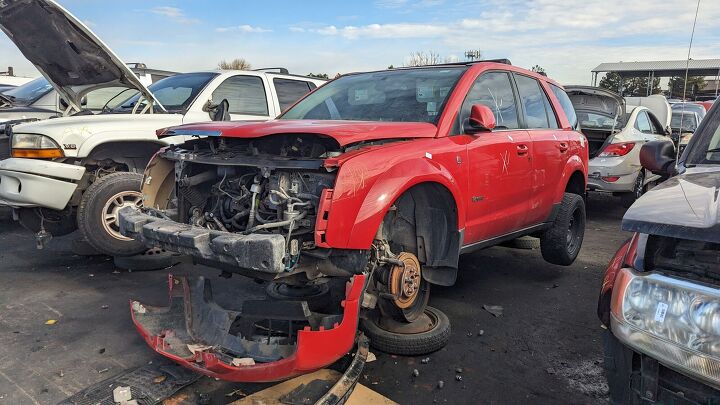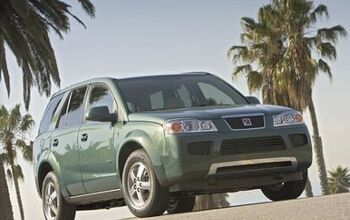Junkyard Find: 2007 Saturn Vue Green Line

Honda beat everybody to the production gasoline-electric hybrid game in the United States, putting the Insight in showrooms in 1999. Toyota followed with the Prius a year later, but it took GM until 2006 to introduce its first true gasoline-electric hybrid here. That car was the 2007 Saturn Vue Green Line, and I managed to find one in a Denver-area car graveyard recently.
Our nameless reviewer felt, back in 2006, that the Vue's panel gaps made it the "automotive equivalent of a shotgun shack" and calculated that the Green Line version would require 90,000 miles of driving with $2.15/gallon gas in order to recoup its cost over the pure-gazzoline version. In fact, fuel prices went insane right around the time that review was written.
If we look at the fine print, GM actually introduced a sort-of-a-hybrid vehicle as a 2004 model, though the 2004 Chevrolet Silverado Hybrid/GMC Sierra Hybrid didn't have regenerative braking.
Ford launched the Escape Hybrid as a 2005 model (its Mercury Mariner and Mazda Tribute siblings showed up a bit later), so The General had some catching up to do in the green-car department. Nissan introduced the Altima Hybrid as a 2007 model (and using licensed Toyota hardware), though it disappeared quickly and without leaving much trace.
Toyota and Honda didn't have much to fear from the Vue Green Line's hybrid technology, but it did benefit from regenerative braking and delivered a pretty good 23 city/29 highway miles per gallon (versus 19/25 mpg for the base Vue with 2.2-liter engine and automatic).
The system replaced the starter motor and alternator with a belt-driven motor/generator rig that generated five horsepower and 48 pound-feet. A 2.4-liter Ecotec gas-burner did most of the work with its 170 horsepower.
You could get a manual transmission in the regular Vue, but the Green Line was slushbox-only.
The green paint has faded from this Green Line badge, but it was supposed to be the Gaia-loving counterpart to the planet-ravaging Saturn Ion Red Line. I have mounted Red Line and Green Line badges side-by-side on my garage wall, in order to represent the duality of man.
The storm clouds over General Motors were getting darker by the minute when this car was built, and Saturn would soon have its head on the chopping block. Geo and Oldsmobile were already gone, with Pontiac and Saturn following in 2010.
The entry-level '07 Vue started at $17,995 (about $27,588 in 2024 dollars), while the Green Line version had an MSRP of $22,995 ($35,254 after inflation). Even with $4/gallon gas ($6.13 gallon in today's money), it would have taken quite a while to break even with the Green Line.
The Vue's platform outlived Saturn and still lives today, though. You'll find its derivatives underpinning everything from the Suzuki XL7 to the Wuling Almaz, and it all began with the 2002 Vue.
The interior isn't bad, but a 17-year-old non-AWD car made by a long-defunct brand doesn't command much resale value these days.
There is a way to recapture the world's imagination. To stay the same in one way, and evolve in another. Chapter 11 bankruptcy was approaching quickly, by the way.
A 2007 Saturn Vue Green Line hybrid in a Colorado wrecking yard.
A 2007 Saturn Vue Green Line hybrid in a Colorado wrecking yard.
A 2007 Saturn Vue Green Line hybrid in a Colorado wrecking yard.
A 2007 Saturn Vue Green Line hybrid in a Colorado wrecking yard.
A 2007 Saturn Vue Green Line hybrid in a Colorado wrecking yard.
A 2007 Saturn Vue Green Line hybrid in a Colorado wrecking yard.
A 2007 Saturn Vue Green Line hybrid in a Colorado wrecking yard.
A 2007 Saturn Vue Green Line hybrid in a Colorado wrecking yard.
A 2007 Saturn Vue Green Line hybrid in a Colorado wrecking yard.
[Images: The Author]
Become a TTAC insider. Get the latest news, features, TTAC takes, and everything else that gets to the truth about cars first by subscribing to our newsletter.

Murilee Martin is the pen name of Phil Greden, a writer who has lived in Minnesota, California, Georgia and (now) Colorado. He has toiled at copywriting, technical writing, junkmail writing, fiction writing and now automotive writing. He has owned many terrible vehicles and some good ones. He spends a great deal of time in self-service junkyards. These days, he writes for publications including Autoweek, Autoblog, Hagerty, The Truth About Cars and Capital One.
More by Murilee Martin
Latest Car Reviews
Read moreLatest Product Reviews
Read moreRecent Comments
- MRF 95 T-Bird The proportions of the 500/Taurus-Montego/Sable were a bit taller, akin to 1940’s-50’s cars in order to cater to crossover buyers as well as older drivers who tend to like to sit a tad higher.
- FreedMike You know, before you judge this IS the same police department that gave Sonny Crockett a Ferrari Testarossa to cruise around in.
- Lou_BC They like "western food"?
- 28-Cars-Later "Inside EVs sent automotive journalist Kevin Williams to the Beijing Auto Show, and Williams walked away feeling like Chinese automakers are, generally speaking, building cars that could come to the States and immediately steal plenty of buyers from American, European, Japanese, and Korean automakers."I doubt this very much because: [list=1][*]Conventional drivetrains are not gonna fly and the Chinese are not going to pay to federalize whatever they're selling in Asia (or they would have by now).[/*][*]Until emissions rules for BEV are drawn up (and I'm sure top men are working on that now) it would be easier to resell BEV Asian market product in the US but you're mostly competing for Tesla owners/fans unless you come in and undercut everyone by 50% or more to grow the market. [/*][/list=1]BEV is not taking off folks, the 7% or so (roughly VWoA, Volvo, and Mazda's historic market share) isn't suddenly going to double or triple at current price to value. If PRC brands were to come in with new commuters at $14,995 and then nickle-and-dime for basic features (i.e. the RyanAir model) its a maybe but they won't. They'll come in 5% under the leaders for MSRP and then wonder why their dealer lots are ghost towns (I'm sure whatever dipsh!t dealer group opens a store for them will add ADM on like clowns too).
- Kjhkjlhkjhkljh kljhjkhjklhkjh weird.. nobody wants to be a cop after cops get held accountable.. And no, this has nothing to do with the ''urban myth of defunding'', the funding reductions in this very article come from a reduction in crime during the pandemic (googlze)... and the voting ''people'' of Floridia not allowing funding increases in a vastly right leaning state, and desantis himself rejecting federal funding according to the googlze ... only top have desantis then TAKE covid relief funds from ARPA (also googlze) .. have fun .. wont be reading any replies since this will bring out all the conspiracy theories, secret cabals, gay mice and gay beer book burners





















































Comments
Join the conversation
I'll say one thing about those plastic bodies: they still look good after a decade and a half. Automakers should be sheathing their cars in petroleum-based plastic before they thin out the "sheet metal" to foil thickness.
There’s one of these around the corner from me. It still runs…driven daily, in fact. That fact always surprises me.